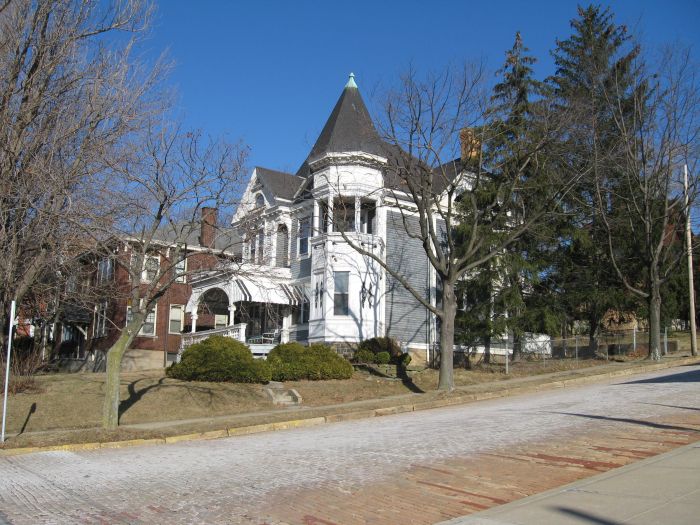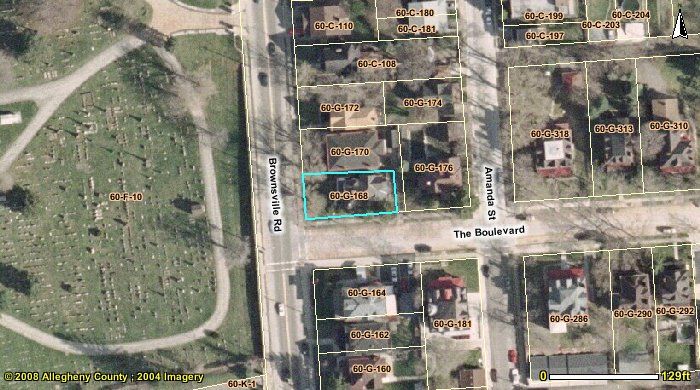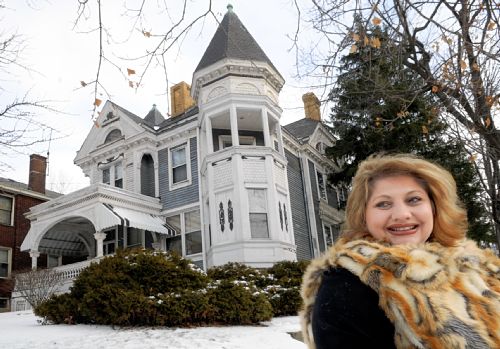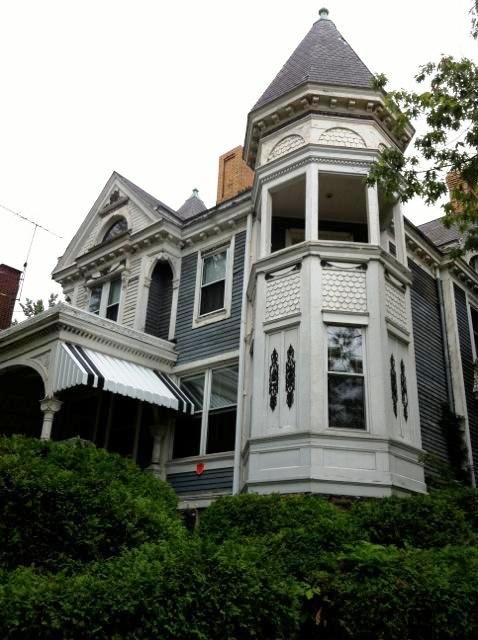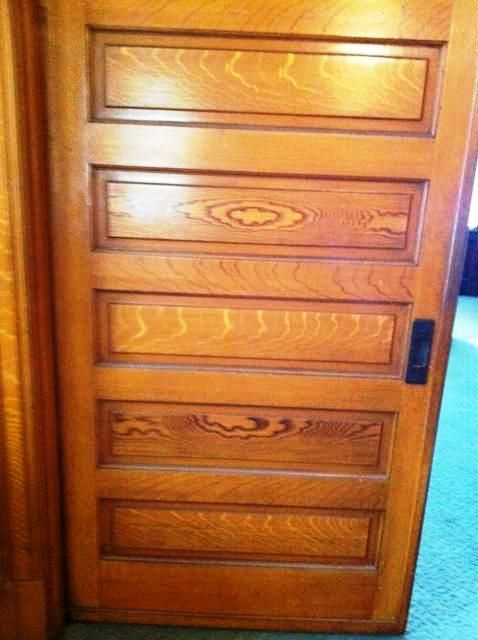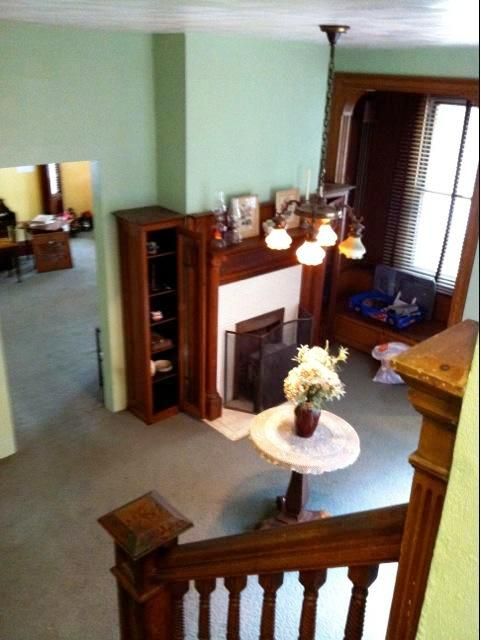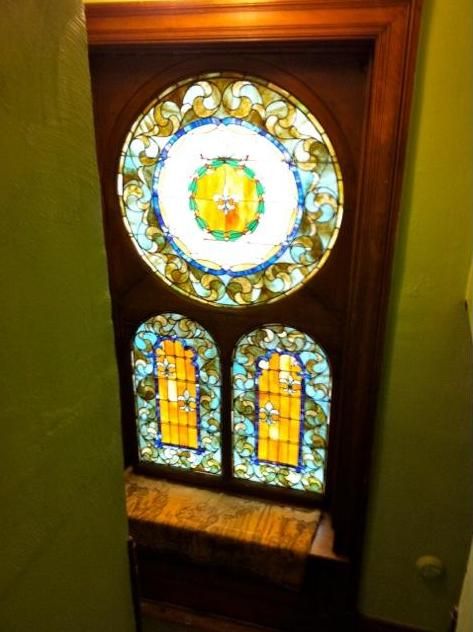Difference between revisions of "Wigman House"
| (6 intermediate revisions by the same user not shown) | |||
| Line 27: | Line 27: | ||
Carrick’s formation as a Borough in 1904 was described as an area “inhabited by wealthy South Side businessmen” so such was the choice of land for a grand home on the new elegant street called that was simply named “The Boulevard.” | Carrick’s formation as a Borough in 1904 was described as an area “inhabited by wealthy South Side businessmen” so such was the choice of land for a grand home on the new elegant street called that was simply named “The Boulevard.” | ||
| − | Ferdinand Benz of the L. Benz Brothers Company was single and did not build on this lot. Perhaps Carrick was too far from his businesses and buildings or maybe he was simply a land speculator because sold the lot to Gwendolen P. Wigman, wife of William H. Wigman | + | Ferdinand Benz of the L. Benz Brothers Company was single and did not build on this lot. Perhaps Carrick was too far from his businesses and buildings or maybe he was simply a land speculator because sold the lot to Gwendolen P. Wigman, wife of William H. Wigman. The deed was recorded on April 2, 1897 for $1,450. Gwendolen P. Wigman then transferred the lot for one dollar to her husband later that year. On November 28th, 1902, Julius Frey sold his property, Lot Number 19 next to Lot Number 20, for the sum of $3,000. |
| − | William H. Wigman was | + | William H. Wigman was the owner of a very prosperous lumber company at 48 South 18th Street on the South Side, Wigman Lumber. The Pittsburgh Street Directory of 1912 lists his home as Baldwin Twp indicating that he built the home sometime before that year and probably shortly after he bought the two lots large enough for his grand Queen Anne style home. |
| − | Supporting the evidence of the home being built before 1905 is indicated in the G. M. Hopkins Maps of 1896 and 1905. In fact between those two dates not only were several mansions built on The Boulevard, a new school for the community, Quentin Roosevelt School can be found. Truly this was fast becoming the location to live in the South Hills. | + | Supporting the evidence of the home being built before 1905 is indicated in the G. M. Hopkins Maps of 1896 and 1905. In fact between those two dates not only were several mansions built on The Boulevard, a new school for the community, Quentin Roosevelt School can be found. Truly this was fast becoming the location to live in the South Hills. Recent documents from the grand daughter of William Wigman indicated the house construction was started in 1895 and finished in 1896. A wedding reception was held in the house in 1906 for William H. and Gwendolen P. Wigman that year. |
The Wigman House at 1425 Brownsville Road reflects the utilization of the best the William Wigman Lumber Company had to offer to design and build this home in the classic American Queen Anne style popular in the late 1800s and early 1900s. The ornate exterior wood trim, the interior doors, woodwork and framing, the pocket doors and even the closet doors are still illustrate how detailed the builder and architect built the home. The woodwork is wood that displays the real graining, without the staining to produce faux stained wood as common in less expensive homes of the time. The large chain hung window/door entrance to the turret balcony reflects the ingenuity of design. The original stained glass windows, which are held by rich wooden framing, indicate great wealth and expertise. | The Wigman House at 1425 Brownsville Road reflects the utilization of the best the William Wigman Lumber Company had to offer to design and build this home in the classic American Queen Anne style popular in the late 1800s and early 1900s. The ornate exterior wood trim, the interior doors, woodwork and framing, the pocket doors and even the closet doors are still illustrate how detailed the builder and architect built the home. The woodwork is wood that displays the real graining, without the staining to produce faux stained wood as common in less expensive homes of the time. The large chain hung window/door entrance to the turret balcony reflects the ingenuity of design. The original stained glass windows, which are held by rich wooden framing, indicate great wealth and expertise. | ||
| Line 38: | Line 38: | ||
On February 23, 1952, Arthur Herrmann sells this property to Regis L. McClory, et. ux, for $11.750. The house is currently owned by Regis L. McClory, deceased, and his wife, Eleanor Marie McClory. | On February 23, 1952, Arthur Herrmann sells this property to Regis L. McClory, et. ux, for $11.750. The house is currently owned by Regis L. McClory, deceased, and his wife, Eleanor Marie McClory. | ||
| − | |||
== [http://www.post-gazette.com/pg/10358/1113145-53.stm Some in Carrick strive to save Victorian house] == | == [http://www.post-gazette.com/pg/10358/1113145-53.stm Some in Carrick strive to save Victorian house] == | ||
| Line 107: | Line 106: | ||
Just as those ghosts clung to the past, so must the ghosts of the last remaining Victorian mansion in Carrick be appeased. | Just as those ghosts clung to the past, so must the ghosts of the last remaining Victorian mansion in Carrick be appeased. | ||
| − | [[Emily | + | [[Emily Prichard Cary]] |
Scottsdale, Ariz | Scottsdale, Ariz | ||
| − | |||
| − | |||
| − | |||
| − | |||
== [http://www.youngpreservationists.org/2011toptenlist Young Preservationists Association Award] == | == [http://www.youngpreservationists.org/2011toptenlist Young Preservationists Association Award] == | ||
| Line 190: | Line 185: | ||
| + | ===Buying Here: Carrick=== | ||
| + | |||
| + | Saturday, May 28, 2011 | ||
| + | |||
| + | By Marylynne Pitz, Pittsburgh Post-Gazette | ||
| + | |||
| + | '''[http://www.post-gazette.com/pg/11148/1149140-30-0.stm click here for Post-Gazette article]''' | ||
| + | |||
| + | In the late 1800s and early 20th century, affluent Americans loved Queen Anne -- the style, that is. Imported from England and introduced at the Philadelphia Centennial Exposition of 1876, the architectural style characterized by "gingerbread" trim, turrets and grand wraparound porches was a hit across the country. | ||
| + | |||
| + | One of Pittsburgh's best examples of an American Queen Anne is at 1425 Brownsville Road (MLS No. 865454), the main thoroughfare in the city neighborhood of Carrick. Listed for $109,900 with Howard Hanna Realtor Mo Kaylor (www.1425brownsvillerd.howardhanna.com), the three-story house with four bedrooms and two bathrooms was built of wood in 1903-1904 by William Wigman, who owned Wigman Lumber on the South Side. | ||
| + | |||
| + | Set on a corner lot, the Wigman House is the first in an impressive row of houses on a brick-paved street called The Boulevard. Walter Kidney, the late architectural historian, devoted an entire page of his 1997 book, "Pittsburgh's Landmark Architecture" to The Boulevard and the house. | ||
| + | |||
| + | "Though not perfectly kept and not designed to a unified scheme, this cluster of turn-of-the-century Colonial Revival houses makes a solid, coherent impression. ... At the junction with Brownsville Road is a remarkable Queen Anne house of wood," he wrote. | ||
| + | |||
| + | The city's Historic Review Commission and Planning Department recently approved designating the house as a historic structure after a nomination by members of the Carrick Overbrook Historical Society, The final decision rests with Pittsburgh City Council; no hearing has been scheduled. | ||
| + | |||
| + | The house presents a huge restoration challenge: The exterior needs a paint job and its interior requires plaster repair, repainting and probably new electrical and plumbing systems. Still, its architectural bones live up to Mr. Kidney's description of "remarkable." | ||
| + | |||
| + | Three elegant white arches frame the front porch, which needs to be stabilized. Ornamental exterior details include dentil molding, spindles and fish scale shingle siding. There's a front-facing gable, a polygonal tower and a second-story balcony that's accessible through an especially tall window in one of the second-floor bedrooms. | ||
| + | |||
| + | The second-floor balcony enchanted Julia Tomasic, a member of the Carrick Overbrook Historical Society who toured the home last year. | ||
| + | |||
| + | "You could sit out there in the middle of the night and watch the world go by," she said. | ||
| + | |||
| + | Unlike many properties from this era, this house was never divided into apartments so its plaster is intact, although some of it is flaking in the first-floor bathroom. The wood and craftsmanship are clearly first rate and it appears that all the hardware on the doors is original. | ||
| + | |||
| + | Inside the front door is a reception room and foyer. To the right is a window seat that has storage beneath it. A built-in bookcase with wooden doors on either side frames the fireplace. To the left is a bay window and a staircase. | ||
| + | |||
| + | The 17-by-15-foot living room has 10-foot ceilings and a pentagonal alcove. It's possible that dead family members were laid out in this space during a wake as that was a common practice during the late 19th and early 20th century. | ||
| + | |||
| + | Functioning pocket doors separate the living room from the 18-by-16-foot dining room, whose fireplace mantel is made from quarter-sawn oak and features carved leaf scrolls. The dining room fireplace is log burning; the other five fireplaces in the home do not work but are truly decorative. | ||
| + | |||
| + | From the foyer, a staircase leads to a landing dominated by three stained-glass windows done mostly in blue and gold with accents of pink, purple and green. Not surprisingly, the glass is buckling slightly after more than a century and metal rods have been placed across the windows to stabilize them. | ||
| + | |||
| + | The 15-by-14-foot kitchen has pine cabinetry and Formica counters installed in 1952, when the ceiling was lowered. There's a large pantry behind an elegant wood door. Off the kitchen is a 40-year-old bathroom. | ||
| + | |||
| + | The second floor contains four spacious bedrooms, three of which have fireplaces. Room sizes are 17 by 12 feet, 16 by 15 feet, 15 by 15 feet and 14 by 10 feet. A second-floor bathroom, installed 40 years ago, is trimmed in blue tile. | ||
| + | |||
| + | The home's slate roof is original, Ms. Kaylor said, and while it has been repaired, there have been no leaks. A new forced air gas furnace was put in about 10 years ago. The first-floor windows were updated about 40 years ago, but windows on the second floor and in the attic are original. The attic runs the length of the house and it's easy to stand upright in it and walk around. | ||
| + | |||
| + | Thieves stole copper plumbing from the basement and kitchen, but bathroom plumbing is intact, Ms. Kaylor said. The property's county assessed value is $64,000 (www2.county.allegheny.pa.us/RealEstate/Search.aspx). | ||
| + | |||
| + | Three nearby houses built around the same time also are on the market now. All on The Boulevard, they're listed for $274,900, $159,900 and $117,000, respectively. | ||
| + | |||
| + | Since 2008, five properties have sold in the 900-1400 blocks of Brownsville Road ranging in price from $42,000 in January 2010 to $125,000 in November 2008 for a four-unit apartment building next to the Wigman House (www.realstats.net). To tour 1425 Brownsville Road, Carrick, contact agent Mo Kaylor at 412-882-9100, ext. 235. | ||
| + | |||
| + | Carrick At a glance | ||
| + | |||
| + | Website: www.carrickpa.com | ||
| + | |||
| + | Incorporated: Originally a separate borough established in 1906, Carrick became a Pittsburgh neighborhood in 1926. | ||
| + | |||
| + | Size: 1.673 square miles | ||
| + | |||
| + | Population: 10,500 (University of Pittsburgh Center for Social and Urban Research) | ||
| + | |||
| + | School district: Pittsburgh (www.ppps.k12.pa.us) | ||
| + | |||
| + | Mean SAT scores: Math, 457; critical reading,432; writing, 430 (Carrick High School) | ||
| + | |||
| + | Annual taxes on a $100,000 house: $2,870 | ||
| + | |||
| + | City: 10.8 mills ($1,080); school: 13.92 mills ($1,392); county 1: 4.69 mills ($398) | ||
| + | |||
| + | Claim to fame: In 1997, Carrick was the first community in the northern United States to be named a "cool community" by the U.S. Department of Energy. Community groups partnered with conservation groups to weatherize homes and businesses, plant trees and flowers and add "green" elements to the renovation of Carrick High School. | ||
| + | |||
| + | 1 includes the Act 50 Homestead Exclusion, which reduces assessed market value by $15,000 for county taxes | ||
| + | |||
| + | ===City Council hearing on Wigman House historic nomination in Carrick=== | ||
| + | |||
| + | '''[http://www.popcitymedia.com/devnews/wigmanhouse062911.aspx click here for Pop City article]''' | ||
| + | |||
| + | WEDNESDAY, JUNE 29, 2011 | ||
| + | |||
| + | The Wigman House in Carrick is being considered for historic landmark status by the City of Pittsburgh. City Council held a public hearing yesterday on historic designation for the Crown Jewel Victorian which had been threatened by plans for demolition earlier this year. Eight residents spoke at the hearing, all in favor of historic designation. | ||
| + | |||
| + | "Anybody that passes this house, this is the highlight of their day," says John Rudiak, of the Carrick-Overbrook Historical Society. "It's just marvelous the way the sun shines on this house all the time, and it always looks magnificent and grand. It makes people smile, it really does." | ||
| + | |||
| + | The Queen Anne Style home, built around 1902, was nominated for historic designation last year by Rudiak and the Historical Society. | ||
| + | |||
| + | The Society was galvanized to preserve the home when state Rep. Harry Readshaw, a potential buyer of the home, said he would consider demolishing the house to create a parking lot for his neighboring funeral home business. | ||
| + | |||
| + | The home is still for sale, but Rudiak says current owner Grace McClory now hopes to see it preserved. In February, the Young Preservationists Association of Pittsburgh named the Wigman House one of the region's top ten preservation opportunities as part of their annual report. | ||
| + | |||
| + | Rudiak cites three other grand, Queen Ann homes that have been demolished in Carrick, one for a road, a second for a parking lot, and a third for a strip mall. | ||
| + | |||
| + | "Everyone that we've talked to in the neighborhood said that it would be a shame to destroy this house," Rudiak says, "This house is the last Queen Anne in Carrick." | ||
| + | |||
| + | |||
| + | Writer: Andrew Moore | ||
| + | Source: John Rudiak | ||
| + | |||
| + | ===Wigman House Receives Historic Designation by Pittsburgh City Council === | ||
| + | |||
| + | File #: 2011-1743 Version: 1 | ||
| + | Type: Resolution Status: Passed Finally | ||
| + | File created: 5/31/2011 In control: Land Use and Economic Development Committee | ||
| + | On agenda: Final action: 7/12/2011 | ||
| + | Enactment date: 7/12/2011 Enactment #: 485 | ||
| + | Effective date: 7/27/2011 | ||
| + | Title: Resolution providing for the designation as a Historic Structure under Title 11 of the Code of Ordinances that certain structure known as the Wigman House, located at 1425 Brownsville Road, block and lot number 60-G-168, in the 29th Ward, City of Pittsburgh. | ||
| + | Indexes: PGH. CODE ORDINANCES TITLE 11 - HISTORIC DESIGNATION | ||
| + | |||
| + | Resolution providing for the designation as a Historic Structure under Title 11 of the Code of Ordinances that certain structure known as the Wigman House, located at 1425 Brownsville Road, block and lot number 60-G-168, in the 29th Ward, City of Pittsburgh. | ||
| + | |||
| + | WHEREAS, the City of Pittsburgh has duly enacted Title 11of the Code of Ordinances, which protects and preserves Historic Structures, Districts, Sites, and Objects; and | ||
| + | |||
| + | WHEREAS, The Carrick-Overbrook Historical Society has nominated the Wigman House (1425 Brownsville Road) for designation as a Historic Structure; and | ||
| + | |||
| + | WHEREAS, the Historic Review Commission has held a public hearing to gather testimony from the property owner and other interested parties concerning the appropriateness of this designation; and | ||
| + | |||
| + | WHEREAS, the Historic Review Commission has voted to recommend that City Council DESIGNATE the Wigman House (1425 Brownsville Road) as a Historic Structure; and | ||
| + | |||
| + | WHEREAS, the City Planning Commission has held a public hearing to gather testimony from the property owner and other interested parties concerning the appropriateness of this designation; and | ||
| + | |||
| + | WHEREAS, the City Planning Commission has voted to recommend that City Council DESIGNATE the Wigman House (1425 Brownsville Road) as a Historic Structure; and | ||
| + | |||
| + | WHEREAS, the Council of the City of Pittsburgh has held a public hearing to gather testimony from the public concerning the appropriateness of this designation; and | ||
| + | |||
| + | WHEREAS, the Council of the City of Pittsburgh finds that the aforementioned building is a Historic Structure that should be preserved; | ||
| + | |||
| + | Be it resolved by the Council of the City of Pittsburgh as follows: | ||
| + | |||
| + | Section 1. Pursuant to the provisions of Title 11 of the Code of Ordinances, the Council of the City of Pittsburgh hereby designates as a Historic Structure the building known as the Wigman House, located at 1425 Brownsville Road, block and lot number 60-G-168, in the 29th Ward, City of Pittsburgh. | ||
===[http://amyrybacki.com/blog/2011/07/wigman-house-tour/ The Beautiful Wigman House] === | ===[http://amyrybacki.com/blog/2011/07/wigman-house-tour/ The Beautiful Wigman House] === | ||
| Line 198: | Line 319: | ||
I toured the Wigman house in Carrick yesterday and I must say, it was one of the most beautiful homes I have ever been in. I was lucky enough to get a tour of the home by Bonnie Kramer, who grew up in the home. | I toured the Wigman house in Carrick yesterday and I must say, it was one of the most beautiful homes I have ever been in. I was lucky enough to get a tour of the home by Bonnie Kramer, who grew up in the home. | ||
| − | [File:Wigman blog 1.jpg] | + | [[File:Wigman blog 1.jpg]] |
Constructed in 1888 for the owner of Wigman Lumber, William Wigman, it is the last of the Victorians on what was known as, “Millionaire’s Row.” It is a beautiful example of a Queen Anne Victorian, boasting a front-facing gable, a large front porch with large arches, dentil molding, fish scale siding, classical columns, and spindles. The most distinctive exterior feature is a polygonal tower with a second-story balcony off one of the home’s four bedrooms. The balcony is accessed through a large window…so charming! | Constructed in 1888 for the owner of Wigman Lumber, William Wigman, it is the last of the Victorians on what was known as, “Millionaire’s Row.” It is a beautiful example of a Queen Anne Victorian, boasting a front-facing gable, a large front porch with large arches, dentil molding, fish scale siding, classical columns, and spindles. The most distinctive exterior feature is a polygonal tower with a second-story balcony off one of the home’s four bedrooms. The balcony is accessed through a large window…so charming! | ||
| Line 205: | Line 326: | ||
| − | [File:Wigman blog 2.jpg] | + | [[File:Wigman blog 2.jpg]] |
The home has 6 fireplaces, one working, the other five decorative. Each fireplace has a different species of wood and a unique marble surround and hearth. The fireplace in the foyer is flanked by built-in bookcases. | The home has 6 fireplaces, one working, the other five decorative. Each fireplace has a different species of wood and a unique marble surround and hearth. The fireplace in the foyer is flanked by built-in bookcases. | ||
| Line 240: | Line 361: | ||
Could you be the next owner of this historic house? Contact Mo Kaylor to find out more and to schedule a tour. Feel free to contact me if you would like me to go with you to see this home. I bet you fall in love like I did! And since I believe this landmark home deserves to be restored to its former glory, I am offering half-off my consulting services to the buyer. I have a lot of great ideas for restoring this gem! I could do a one-time consult to point you in the right directon, or I can work with you through the entire project. | Could you be the next owner of this historic house? Contact Mo Kaylor to find out more and to schedule a tour. Feel free to contact me if you would like me to go with you to see this home. I bet you fall in love like I did! And since I believe this landmark home deserves to be restored to its former glory, I am offering half-off my consulting services to the buyer. I have a lot of great ideas for restoring this gem! I could do a one-time consult to point you in the right directon, or I can work with you through the entire project. | ||
| + | |||
| + | |||
| + | |||
| + | == A house with history in Carrick [http://www.post-gazette.com/stories/life/home/a-house-with-history-in-carrick-672034/ Click Here] == | ||
| + | |||
| + | January 26, 2013 | ||
| + | |||
| + | '''By Marylynne Pitz / Pittsburgh Post-Gazette''' | ||
| + | |||
| + | [[File:Pg story photo 1.jpg]]Photo by Larry Roberts/Post-Gazette | ||
| + | |||
| + | Exterior of the Wigman house on Brownsville Road, now owned by George and Cathy Lewis. | ||
| + | |||
| + | [[File:Pg story photo 2.jpg]] Photo by Larry Roberts/Post-Gazette | ||
| + | |||
| + | The front room of the Wigman house in a photograph taken last summer, showing an original fireplace and mantel. | ||
| + | |||
| + | [[File:Pg story photo 3.jpg]] Photo by Larry Roberts/Post-Gazette | ||
| + | |||
| + | Stained glass on the landing from the first to second floor in the Wigman house in Carrick. | ||
| + | |||
| + | [[File:Pg story 4.jpg]] Photo by Larry Roberts/Post-Gazette | ||
| + | |||
| + | Sitting area off the living room in the Wigman house. | ||
| + | |||
| + | [[File:Pg story photo 5.jpg]] Photo by Larry Roberts/Post-Gazette | ||
| + | |||
| + | Cathy and George Lewis, owners of the Wigman house in Carrick, in front of one of the ornamental wooded mantels, this one in the dining room. | ||
| + | |||
| + | [[File:Pg story photo 6.jpg]] Photo by Larry Roberts/Post-Gazette | ||
| + | |||
| + | Kitty Martin, the granddaughter of William Wigman, who built the Queen Anne house at 1425 Brownsville Road in Carrick, examines the workmanship of the second floor balcony off a bedroom. | ||
| + | |||
| + | |||
| + | Kitty Martin beamed as she walked through the Wigman house last summer, delighted by her first chance to tour the Carrick home where her father was born and grew up. | ||
| + | |||
| + | "My grandfather built this house," the Minneapolis woman said as she admired the Victorian woodwork and enjoyed an expansive view of the neighborhood from a second-floor balcony. "My father was born in this house in July 1901." | ||
| + | |||
| + | Her paternal grandfather, William Henry Wigman, ran a South Side lumber company founded in 1866 and initially called the Union Planing Mill Co. When he and his family moved in in 1896, the home's hand-carved oak staircase, pocket doors and moldings were new. So were the cherry wood mantels in the dining room and living room and the three colorful stained-glass windows on the staircase landing. They're still there. | ||
| + | |||
| + | "The most amazing thing to me is that the house was never divided up, and the woodwork was never painted over," Mrs. Martin said. | ||
| + | |||
| + | Another reason to celebrate is that the house still stands. Set on a corner lot, this Queen Anne-style house is the first in an impressive row of houses on a brick-paved street called The Boulevard. This architectural jewel could have become a parking lot for a nearby funeral home. Now, it has historic status and new owners who appreciate its architectural details. | ||
| + | |||
| + | Three white arches frame the front porch. Exterior decoration includes dentil molding and fish scale shingle siding. There's a front-facing gable, a polygonal tower and a second-story balcony that's accessible through an especially tall window in a second-floor bedroom. | ||
| + | |||
| + | Cathy and George Lewis, formerly of Mount Washington, bought the Wigman house last spring for $70,000 and are gradually restoring it. They moved in last September and have rebuilt the front and back porches. | ||
| + | |||
| + | "I always wanted to live in a great big house like that," said Mrs. Lewis, who grew up in Peters, Washington County, and works in the information technology department at the law firm of Houston Harbaugh. | ||
| + | |||
| + | Mr. Lewis is a retired auto mechanic. | ||
| + | |||
| + | "He's becoming very handy. Fortunately, the bones of this house were very, very good. The outside needs a good paint job. We're not going to tackle that on our own," Mrs. Lewis said. | ||
| + | |||
| + | The Lewises saw the spacious home because their daughter, Shannon, considered buying it before purchasing a Brentwood property instead. | ||
| + | |||
| + | "We went and took a second look at it and decided to buy it. We want to ... turn it into a tea room," Mrs. Lewis said, adding that visitors to the Harry Readshaw funeral home, just across the street, would be likely customers. A china cupboard in the foyer already holds an array of 35 colorful tea cups, a gift from one of her cousins. | ||
| + | |||
| + | The Lewises had lots of support from three committed volunteers who founded the Carrick-Overbrook Historical Society -- Julia Tomasic, John Rudiak and Carol Anthony. Another advocate was Bonnie Kramer, who grew up in the Wigman house during the 1950s and lives in a log home in McClellandtown, Fayette County. She persuaded the house's former owner, her stepmother Grace McClory, to let her take the lead on finding a sympathetic buyer. | ||
| + | |||
| + | "I'm not of that generation where you throw away and buy new. Even as a decorator, I try to find a second life and repurpose things. I really felt it was important to make sure the right person bought it," Mrs. Kramer said. | ||
| + | |||
| + | All those efforts paid off when the city's Historic Review Commission designated the house as historic in April 2011. | ||
| + | Since last summer, the Lewises have been busy painting the foyer, living room and dining room, using 20 gallons of Behr paint donated by Home Depot. Four of Mrs. Lewis' office mates showed up at 8 a.m. on four Saturdays to attend "painting parties." The crew included Carol Kushner, Corinne McCartney, Karen Schwartz and Jane Settembre. Now, the living room and dining room are gold, and long sage green damask curtains decorate both rooms. | ||
| + | |||
| + | "Carol was known as 'two-coat Carol.' She wears that tag proudly," Mrs. Lewis said. | ||
| + | |||
| + | The slate roof needed repairs, and old knob-and-tube electrical wiring was replaced. New plumbing was installed, too. The Lewises are buying antiques to decorate their new home, including a game table and a pie-crust table for the dining room. At Christmas, they wrapped garlands around the fireplace mantels and decorated a 7-foot tree that stood in the front turret window. An annual gathering of cousins convened here, too. | ||
| + | |||
| + | Just seeing the house where her family grew up was a gift to Mrs. Martin. In the early 1980s, she took her father, Donald Prosser Wigman, to visit Carrick. | ||
| + | "He wanted to see his house again. We stood out there on the corner. We never came up and knocked on the door. We thought it had been divided up into apartments," Mrs. Martin said, adding that her father could not bear to see that. | ||
| + | |||
| + | "I'm so thankful to the Lewises for buying this house and to Bonnie [Kramer] for being strong and saying, 'I want this house to be saved.' It just makes me so grateful that somebody loves that house and that it's still standing." | ||
| + | |||
| + | |||
| + | |||
| + | Marylynne Pitz: mpitz@post-gazette.com or 412-263-1648. | ||
| + | First Published January 26, 2013 12:00 am | ||
| + | |||
| + | [http://www.post-gazette.com/stories/life/home/a-house-with-history-in-carrick-672034/#ixzz2J7ohNGlL Read more click here] | ||
Latest revision as of 15:31, 26 January 2013
Contents
- 1 For over 100 years this house didn't have a name it was simply our Crown Jewel. Through our research into this Queen Anne Victorian house we can now call it "The Wigman House" after the owner and builder, William Wigman of Wigman Lumber. This is our Crown Jewel Victorian and is the last standing example of our past. Let's hope that it never gets destroyed by anyone!
- 2 Description of the Wigman House, American Queen Anne style, 1425 Brownsville Road, Pittsburgh, PA 15210
- 3 History of the Wigman House, a Queen Anne Victorian,
- 4 AKA 1425 Brownsville Road, Pittsburgh, PA 15210
- 5 Some in Carrick strive to save Victorian house
- 6 Young Preservationists Association Award
- 7 YPA Releases 2011 Top Ten List
- 8 A house with history in Carrick Click Here
For over 100 years this house didn't have a name it was simply our Crown Jewel. Through our research into this Queen Anne Victorian house we can now call it "The Wigman House" after the owner and builder, William Wigman of Wigman Lumber. This is our Crown Jewel Victorian and is the last standing example of our past. Let's hope that it never gets destroyed by anyone!
Description of the Wigman House, American Queen Anne style, 1425 Brownsville Road, Pittsburgh, PA 15210
The Wigman House at 1425 Brownsville Road was built to the Queen Anne Style buildings and is an excellent example of the style containing almost all of the classic elements of the style. The Queen Ann Style buildings in America came into vogue in the 1880s and this house was built in or around 1902. Because the popularity of high Queen Anne Style waned in the early 1900s this house is the only example of that architectural style existing in the immediate area.
Many of the distinctive features of American Queen Anne style can be found in the Wigman house including asymmetrical facade; dominant front-facing gable, cantilevered out beyond the plane of the wall below; overhanging eaves; a polygonal tower; shaped and Dutch gables; a porch covering part or all of the front facade, including the primary entrance area; a second-story porch or balconies; pedimented porches; differing wall textures, such as patterned wood shingles shaped into varying designs, including resembling fish scales, relief panels; dentils; classical columns; spindle work; oriel and bay windows; a large leaded stained glass window; monumental chimneys; painted balustrades; and a slate roof.
The interior of the house reflects the best wood, doors, woodwork and framing. Even the stained glass windows have wooden framing around each of the three windows for added support and appearance. The pocket doors between the living room parlor and the dining room function with ease. The six working fireplaces fine carved wood, marble or slate indicate the details of wealth that went into the house.
History of the Wigman House, a Queen Anne Victorian,
AKA 1425 Brownsville Road, Pittsburgh, PA 15210
The history of 1425 Brownsville Road begins on August 15, 1890 when Ferdinand Benz buys Lot Number 20 in a plan called the South View Place, for $300. The lot was in a plan laid out by the Birmingham Land Improvement Company in Baldwin Township, now the neighborhood of Carrick in the city of Pittsburgh, PA. The property fronted what was known as Southern Avenue now Brownsville Road and The Boulevard.
Ferdinand Benz was the best known German banker of Pittsburgh . He was a member of the contracting firm of L. Benz Brothers, an organization which built many buildings in Pittsburgh city and Pittsburgh’s South Side, including the People’s Trust Company on 18th and Carson, South Side Market house in 1893. Mr. Benz was also was Vice President of the German Savings and Deposit Company on the South Side and a Director in the First National Bank of Birmingham, as well as a stockholder in almost every bank in Pittsburgh. He had a very large fortune when he died according to the obituary in The New York Times.1
The choice of Baldwin Township’s Carrick section to buy this property perhaps for his home can only be assumed at this point. However, since he was a Director in the First National Bank of Birmingham he had to have known the President Thomas H. Sankey who also was to build a huge home on The Boulevard.
Carrick’s formation as a Borough in 1904 was described as an area “inhabited by wealthy South Side businessmen” so such was the choice of land for a grand home on the new elegant street called that was simply named “The Boulevard.”
Ferdinand Benz of the L. Benz Brothers Company was single and did not build on this lot. Perhaps Carrick was too far from his businesses and buildings or maybe he was simply a land speculator because sold the lot to Gwendolen P. Wigman, wife of William H. Wigman. The deed was recorded on April 2, 1897 for $1,450. Gwendolen P. Wigman then transferred the lot for one dollar to her husband later that year. On November 28th, 1902, Julius Frey sold his property, Lot Number 19 next to Lot Number 20, for the sum of $3,000.
William H. Wigman was the owner of a very prosperous lumber company at 48 South 18th Street on the South Side, Wigman Lumber. The Pittsburgh Street Directory of 1912 lists his home as Baldwin Twp indicating that he built the home sometime before that year and probably shortly after he bought the two lots large enough for his grand Queen Anne style home.
Supporting the evidence of the home being built before 1905 is indicated in the G. M. Hopkins Maps of 1896 and 1905. In fact between those two dates not only were several mansions built on The Boulevard, a new school for the community, Quentin Roosevelt School can be found. Truly this was fast becoming the location to live in the South Hills. Recent documents from the grand daughter of William Wigman indicated the house construction was started in 1895 and finished in 1896. A wedding reception was held in the house in 1906 for William H. and Gwendolen P. Wigman that year.
The Wigman House at 1425 Brownsville Road reflects the utilization of the best the William Wigman Lumber Company had to offer to design and build this home in the classic American Queen Anne style popular in the late 1800s and early 1900s. The ornate exterior wood trim, the interior doors, woodwork and framing, the pocket doors and even the closet doors are still illustrate how detailed the builder and architect built the home. The woodwork is wood that displays the real graining, without the staining to produce faux stained wood as common in less expensive homes of the time. The large chain hung window/door entrance to the turret balcony reflects the ingenuity of design. The original stained glass windows, which are held by rich wooden framing, indicate great wealth and expertise.
On March 19, 1919, William H. Wigman sold the house to William Wigman, for $1 and this deed indicate Lots 19 and 20. This was possibly a formality because on June 12, 1919, William Wigman sells the property to Mary E. Herrmann for $8,000. Mary E. Herrmann transfers the same property to Walter J. Herrmann, her son, on September 16, 1941. Walter J. Herrmann died on April 21, 1942 and, by will, gave the property to his mother, but his mother died before he did, so the heirs of Walter J. Hermann’s divided the estate, viz (deed language): Mary Herrmann, his widow, and William J. Herrmann and Arthur Herrmann, his sons. By deed dated February 1. 1951 granted and conveyed all their interest to Arthur Herrmann.
On February 23, 1952, Arthur Herrmann sells this property to Regis L. McClory, et. ux, for $11.750. The house is currently owned by Regis L. McClory, deceased, and his wife, Eleanor Marie McClory.
Some in Carrick strive to save Victorian house
Friday, December 24, 2010
By Diana Nelson Jones, Pittsburgh Post-Gazette
Julia Tomasic of the Carrick-Overbrook Historical Society is trying to save the last great Victorian home in Carrick, at 1425 Brownsville Road, by nominating it for historic status
At one corner of Brownsville Road and The Boulevard in Carrick sits state Rep. Harry Readshaw's funeral home. Across The Boulevard, a late-19th-century Queen Anne house is the last of the grand Victorians remaining on the main drag.
Its owners want to sell and may have a buyer in Mr. Readshaw, who said he is interested in buying the property and that demolishing it to provide parking "might be a decision to be considered."
Mr. Readshaw's interest has spurred the Carrick-Overbrook Historical Society to try to save the house.
Historical society member John Rudiak documented the property and this week nominated it for historical designation. He said demolition of the house would put an end to any evidence of Carrick's Victorian heritage.
The nomination would stall any plan to demolish the house until the Historic Review Commission could determine whether it is eligible, based on a set of federal criteria. Eligibility ultimately must be decided by Pittsburgh City Council. Historic status regulates changes to a building's exterior but not to its interior.
Richard C. Gasior, whose wife's family has owned the four-bedroom home since 1952, said the family needs to sell it and has been advised that $150,000 would be a fair price. "If I can't get anybody to buy it, I'm going to go with Readshaw," he said.
Known as the Wigman House, it was built in the late 1800s by William Wigman, owner of Wigman Lumber on the South Side. The nomination states that it is "the last remaining example of several homes of the wealthy South Side gentry who lived in Carrick."
The current owners gave a tour to members of the Carrick-Overbrook Historical Society several weeks ago, said Julia Tomasic, a founding member of the society.
"We'd love to buy it, but there are just three of us" in the society, which has no money, Ms. Tomasic said. "It has a brand-new furnace, a slate roof and the interior woodwork and walls in original hardwood, with six fireplaces, including one converted for wood. Nothing has been done to alter it."
According to the Pittsburgh code for historic preservation, a property must meet at least one of 10 criteria to be eligible for preservation.
The nomination papers cite several possible eligibilities. One is that the home, a classic American Queen Anne, has not been modified. Its features include an asymmetrical facade, front-facing gable, overhanging eaves, polygonal tower, shaped and Dutch gables, a porch covering part or all of the front facade, a second-story porch or balconies, pedimented porches, dentils, spindles, differing wall textures including fish scales, and oriel and bay windows.
"We heard rumors for a year that Harry [Readshaw] would buy it to tear it down, and we thought it was a joke because we consider Harry a friend of the neighborhood," Ms. Tomasic said. "Parking? You park on the street. We're city people."
"It's not like I'm sitting here champing at the bit with a sledge hammer," Mr. Readshaw, D-Carrick, said, "but business is business and any business is looking to improve its services."
"And if we don't get it, what happens to it?" he said. "Somebody dying to live in a big Victorian who would be a wonderful neighbor would be a positive." A Section 8 landlord is a more likely prospect, he said, adding, "The 29th Ward has been inundated with Section 8 housing."
Brownsville Road once had several grand Victorian homes owned by prominent businessmen. As a hilltop neighborhood, Carrick was a refuge from the smoky city. Through much of the 20th century, it was solidly middle class and owner-occupied. It remains so, but some of its stability is eroding.
In its argument for historic status, the historical society calls the Wigman House the most prominent home in Carrick, "our crown jewel Victorian." Losing it would be a shock, the document reads, and "one more loss that we cannot sustain."
Diana Nelson Jones: djones@post-gazette.com or 412-263-1626. Read her blog City Walkabout at http://blogs.sites.post-gazette.com.
First published on December 24, 2010 at 12:00 am
This beautiful structure must be saved
Letters to the editor Pittsburgh Post-Gazette
Wednesday, January 05, 2011
The late 19th-century Queen Anne Victorian house on Brownsville Road in Carrick ("Some in Carrick Strive to Save Victorian House," Dec. 24) is a gem that must be preserved.
The Carrick-Overbrook Historical Society has done a yeoman's job by documenting the property known as the Wigman House and nominating it for historical designation. One hopes that other area historical societies and individual philanthropists will join together to assure its salvation.
While I was growing up on Madeline Street in Carrick, dozens of comparable homes in the area reflected the personalities of the moguls who built them on high ground in order to contemplate the night sky burned red by the glow of steel mills blazing far below.
My family's physician, Dr. Askins, was able to purchase one such mansion on Brownsville Road during the Depression. The exterior, painted contrasting shades of green, emphasized the eerie atmosphere that would have captivated the Addams Family.
Each time we visited his office, I was startled by creaking sounds -- veritable moans -- coming from one of the turrets. When I asked him about them, he tossed me a sly smile. "Those are the ghosts of the original owners," he said. "They cannot bear to leave the tower and lose sight of the city they built."
Just as those ghosts clung to the past, so must the ghosts of the last remaining Victorian mansion in Carrick be appeased.
Emily Prichard Cary Scottsdale, Ariz
Young Preservationists Association Award
YPA Releases 2011 Top Ten List
Posted On: February 24, 2011
The Young Preservationists Association has released its 2011 list of the Top Ten Best Preservation Opportunities, which marks the start of National Historic Preservation Month (May). The list, released annually, includes endangered historic sites in the Pittsburgh area that are good candidates for preservation and reuse.
YPA will release a printed copy of its 2011 Top Ten report at its annual Preservation Month Celebration on Friday, May 6th, at the Paramount Pictures Film Exchange, from 6 to 8 p.m. Event details are on YPA’s website, May 6
Since 2003, YPA has celebrated historic preservation with its annual list of the Top Ten Best Preservation Opportunities in the Pittsburgh Area. The list, compiled from nominations received from various individuals and organizations, is designed to encourage investment in historic sites throughout the nine-county southwestern Pennsylvania region. The list has been used by property owners to draw positive attention to their properties, raise investment funds, secure grants, and generate political goodwill for their historic sites.
In fact, since YPA released its first Top Ten List in 2003, more than $80 million has been invested into properties placed on YPA’s Top 10 List, including the creation of an estimated 1,245 construction and trade-related jobs, 230 housing units, and $750,000 in additional annual wage tax revenue is yielded to state and local municipalities, as documented in YPA’s 2010 report, “The Economic Impact of Historic Preservation in Southwestern Pennsylvania: Jobs that cannot be outsourced.” Download the Economic Impact Report here: Economic Impact in SW PA.
The criteria used to select the Top Ten List include the following:
1. 50-year Threshold (is it 50 years old or older);
2. Historic & Architectural Significance;
3. Threats to the Site;
4. Community Input; and
5. Feasibility of the Solution.
Below are the Top Ten Best Preservation Opportunities in the Pittsburgh Area for 2011.
10. Connellsville Armory, Connellsville, Fayette County
9. Saints Peter and Paul Church, East Liberty (Pittsburgh)
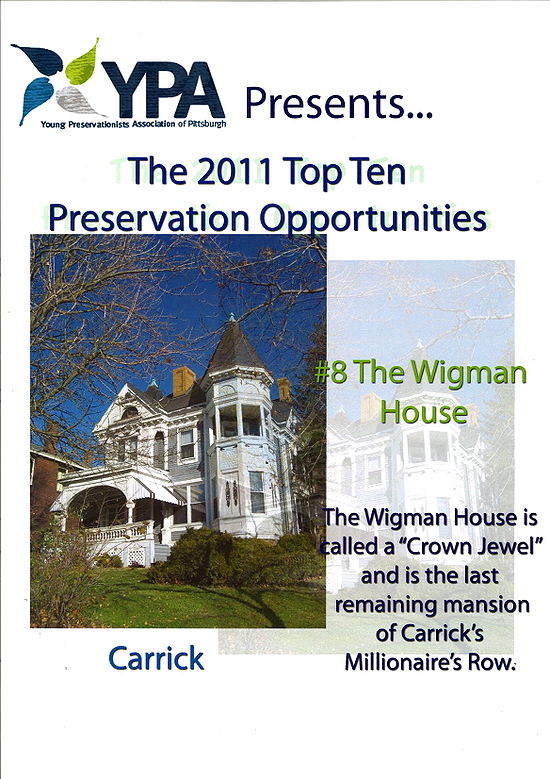 8. Wigman House, Carrick (Pittsburgh)
8. Wigman House, Carrick (Pittsburgh)
7. Stables Building, Allegheny West (Pittsburgh)
6. Westinghouse Atom Smasher, Forest Hills, Allegheny County
5. Hipwell Building, Alleghney West (Pittsburgh)
4. Old Masons Building, Uniontown, Fayette County
3. Highland Building, East Liberty (Pittsburgh)
2. Grand Theatre, Elizabeth (Pittsburgh)
1. Main Street Waynesburg, Waynesburg, Greene County (featured below)
A low-res. copy of the final report can be found here: Celebrate Historic Treasures in Southwestern Pennsylvania: Top Ten Best Historic Preservation Opportunities in the Pittsburgh Area 2011
Past sites have included the Armstrong Cork Factory, Union Project, and the New Granada Theatre, all of which have been restored or stabilized.
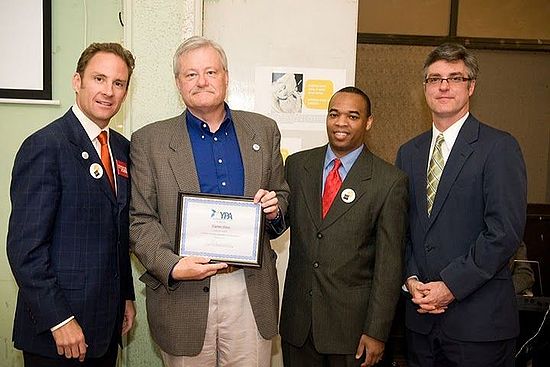 John Rudiak accepts the award on behalf of The Carrick-Overbrook Historical Society
John Rudiak accepts the award on behalf of The Carrick-Overbrook Historical Society
Stay tuned to YPA’s Facebook Page for more details. Posted by Dan Holland | Filed Under Blog, Events
Historic review board OKs Wigman House
Thursday, April 07, 2011
Pittsburgh Post-Gazette
The Historic Review Commission Wednesday unanimously approved recommending historic status for the Wigman House at 1425 Brownsville Road.
Nominated by the Carrick-Overbrook Historical Society in part for being the only great Queen Anne remaining on a road that once had several, it is owned by Grace McClory. Some of her relatives attended the meeting to oppose the nomination but were denied a hearing because the hearing process was ended last month.
The matter has two subsequent hearings before the planning commission and city council. They have yet to be scheduled.
First published on April 7, 2011 at 12:00 am
Buying Here: Carrick
Saturday, May 28, 2011
By Marylynne Pitz, Pittsburgh Post-Gazette
click here for Post-Gazette article
In the late 1800s and early 20th century, affluent Americans loved Queen Anne -- the style, that is. Imported from England and introduced at the Philadelphia Centennial Exposition of 1876, the architectural style characterized by "gingerbread" trim, turrets and grand wraparound porches was a hit across the country.
One of Pittsburgh's best examples of an American Queen Anne is at 1425 Brownsville Road (MLS No. 865454), the main thoroughfare in the city neighborhood of Carrick. Listed for $109,900 with Howard Hanna Realtor Mo Kaylor (www.1425brownsvillerd.howardhanna.com), the three-story house with four bedrooms and two bathrooms was built of wood in 1903-1904 by William Wigman, who owned Wigman Lumber on the South Side.
Set on a corner lot, the Wigman House is the first in an impressive row of houses on a brick-paved street called The Boulevard. Walter Kidney, the late architectural historian, devoted an entire page of his 1997 book, "Pittsburgh's Landmark Architecture" to The Boulevard and the house.
"Though not perfectly kept and not designed to a unified scheme, this cluster of turn-of-the-century Colonial Revival houses makes a solid, coherent impression. ... At the junction with Brownsville Road is a remarkable Queen Anne house of wood," he wrote.
The city's Historic Review Commission and Planning Department recently approved designating the house as a historic structure after a nomination by members of the Carrick Overbrook Historical Society, The final decision rests with Pittsburgh City Council; no hearing has been scheduled.
The house presents a huge restoration challenge: The exterior needs a paint job and its interior requires plaster repair, repainting and probably new electrical and plumbing systems. Still, its architectural bones live up to Mr. Kidney's description of "remarkable."
Three elegant white arches frame the front porch, which needs to be stabilized. Ornamental exterior details include dentil molding, spindles and fish scale shingle siding. There's a front-facing gable, a polygonal tower and a second-story balcony that's accessible through an especially tall window in one of the second-floor bedrooms.
The second-floor balcony enchanted Julia Tomasic, a member of the Carrick Overbrook Historical Society who toured the home last year.
"You could sit out there in the middle of the night and watch the world go by," she said.
Unlike many properties from this era, this house was never divided into apartments so its plaster is intact, although some of it is flaking in the first-floor bathroom. The wood and craftsmanship are clearly first rate and it appears that all the hardware on the doors is original.
Inside the front door is a reception room and foyer. To the right is a window seat that has storage beneath it. A built-in bookcase with wooden doors on either side frames the fireplace. To the left is a bay window and a staircase.
The 17-by-15-foot living room has 10-foot ceilings and a pentagonal alcove. It's possible that dead family members were laid out in this space during a wake as that was a common practice during the late 19th and early 20th century.
Functioning pocket doors separate the living room from the 18-by-16-foot dining room, whose fireplace mantel is made from quarter-sawn oak and features carved leaf scrolls. The dining room fireplace is log burning; the other five fireplaces in the home do not work but are truly decorative.
From the foyer, a staircase leads to a landing dominated by three stained-glass windows done mostly in blue and gold with accents of pink, purple and green. Not surprisingly, the glass is buckling slightly after more than a century and metal rods have been placed across the windows to stabilize them.
The 15-by-14-foot kitchen has pine cabinetry and Formica counters installed in 1952, when the ceiling was lowered. There's a large pantry behind an elegant wood door. Off the kitchen is a 40-year-old bathroom.
The second floor contains four spacious bedrooms, three of which have fireplaces. Room sizes are 17 by 12 feet, 16 by 15 feet, 15 by 15 feet and 14 by 10 feet. A second-floor bathroom, installed 40 years ago, is trimmed in blue tile.
The home's slate roof is original, Ms. Kaylor said, and while it has been repaired, there have been no leaks. A new forced air gas furnace was put in about 10 years ago. The first-floor windows were updated about 40 years ago, but windows on the second floor and in the attic are original. The attic runs the length of the house and it's easy to stand upright in it and walk around.
Thieves stole copper plumbing from the basement and kitchen, but bathroom plumbing is intact, Ms. Kaylor said. The property's county assessed value is $64,000 (www2.county.allegheny.pa.us/RealEstate/Search.aspx).
Three nearby houses built around the same time also are on the market now. All on The Boulevard, they're listed for $274,900, $159,900 and $117,000, respectively.
Since 2008, five properties have sold in the 900-1400 blocks of Brownsville Road ranging in price from $42,000 in January 2010 to $125,000 in November 2008 for a four-unit apartment building next to the Wigman House (www.realstats.net). To tour 1425 Brownsville Road, Carrick, contact agent Mo Kaylor at 412-882-9100, ext. 235.
Carrick At a glance
Website: www.carrickpa.com
Incorporated: Originally a separate borough established in 1906, Carrick became a Pittsburgh neighborhood in 1926.
Size: 1.673 square miles
Population: 10,500 (University of Pittsburgh Center for Social and Urban Research)
School district: Pittsburgh (www.ppps.k12.pa.us)
Mean SAT scores: Math, 457; critical reading,432; writing, 430 (Carrick High School)
Annual taxes on a $100,000 house: $2,870
City: 10.8 mills ($1,080); school: 13.92 mills ($1,392); county 1: 4.69 mills ($398)
Claim to fame: In 1997, Carrick was the first community in the northern United States to be named a "cool community" by the U.S. Department of Energy. Community groups partnered with conservation groups to weatherize homes and businesses, plant trees and flowers and add "green" elements to the renovation of Carrick High School.
1 includes the Act 50 Homestead Exclusion, which reduces assessed market value by $15,000 for county taxes
City Council hearing on Wigman House historic nomination in Carrick
click here for Pop City article
WEDNESDAY, JUNE 29, 2011
The Wigman House in Carrick is being considered for historic landmark status by the City of Pittsburgh. City Council held a public hearing yesterday on historic designation for the Crown Jewel Victorian which had been threatened by plans for demolition earlier this year. Eight residents spoke at the hearing, all in favor of historic designation.
"Anybody that passes this house, this is the highlight of their day," says John Rudiak, of the Carrick-Overbrook Historical Society. "It's just marvelous the way the sun shines on this house all the time, and it always looks magnificent and grand. It makes people smile, it really does."
The Queen Anne Style home, built around 1902, was nominated for historic designation last year by Rudiak and the Historical Society.
The Society was galvanized to preserve the home when state Rep. Harry Readshaw, a potential buyer of the home, said he would consider demolishing the house to create a parking lot for his neighboring funeral home business.
The home is still for sale, but Rudiak says current owner Grace McClory now hopes to see it preserved. In February, the Young Preservationists Association of Pittsburgh named the Wigman House one of the region's top ten preservation opportunities as part of their annual report.
Rudiak cites three other grand, Queen Ann homes that have been demolished in Carrick, one for a road, a second for a parking lot, and a third for a strip mall.
"Everyone that we've talked to in the neighborhood said that it would be a shame to destroy this house," Rudiak says, "This house is the last Queen Anne in Carrick."
Writer: Andrew Moore
Source: John Rudiak
Wigman House Receives Historic Designation by Pittsburgh City Council
File #: 2011-1743 Version: 1 Type: Resolution Status: Passed Finally File created: 5/31/2011 In control: Land Use and Economic Development Committee On agenda: Final action: 7/12/2011 Enactment date: 7/12/2011 Enactment #: 485 Effective date: 7/27/2011 Title: Resolution providing for the designation as a Historic Structure under Title 11 of the Code of Ordinances that certain structure known as the Wigman House, located at 1425 Brownsville Road, block and lot number 60-G-168, in the 29th Ward, City of Pittsburgh. Indexes: PGH. CODE ORDINANCES TITLE 11 - HISTORIC DESIGNATION
Resolution providing for the designation as a Historic Structure under Title 11 of the Code of Ordinances that certain structure known as the Wigman House, located at 1425 Brownsville Road, block and lot number 60-G-168, in the 29th Ward, City of Pittsburgh.
WHEREAS, the City of Pittsburgh has duly enacted Title 11of the Code of Ordinances, which protects and preserves Historic Structures, Districts, Sites, and Objects; and
WHEREAS, The Carrick-Overbrook Historical Society has nominated the Wigman House (1425 Brownsville Road) for designation as a Historic Structure; and
WHEREAS, the Historic Review Commission has held a public hearing to gather testimony from the property owner and other interested parties concerning the appropriateness of this designation; and
WHEREAS, the Historic Review Commission has voted to recommend that City Council DESIGNATE the Wigman House (1425 Brownsville Road) as a Historic Structure; and
WHEREAS, the City Planning Commission has held a public hearing to gather testimony from the property owner and other interested parties concerning the appropriateness of this designation; and
WHEREAS, the City Planning Commission has voted to recommend that City Council DESIGNATE the Wigman House (1425 Brownsville Road) as a Historic Structure; and
WHEREAS, the Council of the City of Pittsburgh has held a public hearing to gather testimony from the public concerning the appropriateness of this designation; and
WHEREAS, the Council of the City of Pittsburgh finds that the aforementioned building is a Historic Structure that should be preserved;
Be it resolved by the Council of the City of Pittsburgh as follows:
Section 1. Pursuant to the provisions of Title 11 of the Code of Ordinances, the Council of the City of Pittsburgh hereby designates as a Historic Structure the building known as the Wigman House, located at 1425 Brownsville Road, block and lot number 60-G-168, in the 29th Ward, City of Pittsburgh.
The Beautiful Wigman House
Monday, July 25th, 2011
I toured the Wigman house in Carrick yesterday and I must say, it was one of the most beautiful homes I have ever been in. I was lucky enough to get a tour of the home by Bonnie Kramer, who grew up in the home.
Constructed in 1888 for the owner of Wigman Lumber, William Wigman, it is the last of the Victorians on what was known as, “Millionaire’s Row.” It is a beautiful example of a Queen Anne Victorian, boasting a front-facing gable, a large front porch with large arches, dentil molding, fish scale siding, classical columns, and spindles. The most distinctive exterior feature is a polygonal tower with a second-story balcony off one of the home’s four bedrooms. The balcony is accessed through a large window…so charming!
Inside the home has beautiful woodwork, much of it grained, and luckily has not been painted over. The pocket doors between the living room and dining room are especially beautiful, and fully functional. This, as well as the other doors in the house, have the original hardware.
The home has 6 fireplaces, one working, the other five decorative. Each fireplace has a different species of wood and a unique marble surround and hearth. The fireplace in the foyer is flanked by built-in bookcases.
The first floor has a living room, with a pentagonal alcove, dining room, foyer with bay window and window seat, kitchen, and bathroom. The rooms are large, and the ceilings high (10-foot, except for the kitchen which has a drop ceiling.)
The kitchen needs work, but is a roomy 15-by-14 so there are lots of possibilities.
Off the kitchen is a large butler’s pantry that was converted into a bathroom. The original zinc-lined cabinets are stored in the home’s basement, so restoring the butler’s pantry would not be difficult if the new owner chooses to do so. Bonnie thinks it would be a great idea to keep a smaller bathroom and restore the cabinets to the pantry. There certainly would be enough room to do so.
Another pantry door in the kitchen hides the original butler’s stairs. The staircase was closed off when a closet was added to the main staircase, but it could easily be re-opened. This would be a must for me. I always wanted a “secret staircase.”
The main staircase landing has three beautiful stained glass windows.
The second floor has four bedrooms, one of which has a linoleum floor and contains a washer/dryer. The room could be converted back into a bedroom if needed, though a second floor laundry is a nice feature.
The third floor is an unfinished attic, but the room is filled with possibilities. It is a great space, and the ceilings are high enough to convert into another bedroom or a family room.
Though the house is architecturally fantastic, it is not without some hard work ahead for the future buyer. The exterior needs painted, and the front porch looks like it needs to be stabilized. The slate roof is original to the house, and the roof has intergral gutters. From what I could tell from my vantage point on the ground, the roof looks to be in decent shape, but I would recommend an assessment of it and the gutter system before any interior restoration work would start.
Inside, electrical and plumbing should be upgraded. The heating system is relatively new, and since it is forced air, air conditioning can be added. The kitchen will need updated, and plaster needs to be repaired in many of the rooms. The hardwood will have to be refinished, and the beautiful stained glass in the stairway landing will need to be restored. The windows on the second floor and attic are original, and just need some fine tuning to be serviceable again.
On February 24, 2011 the Young Preservationists Association of Pittsburgh named their 2011 Top Ten best preservation opportunities in the Pittsburgh Area, and named the Wigman House #8. (The Young Preservationists do a great job of promoting preservation opportunities. Consider becoming a member or donating!)
None of the work needed is unusual for a home this age. Considering no major alterations have ever been made, restoration work will be much easier. Depending on how handy the buyer is, a lot of the projects could be DIY. Even with the to-do list, this is a remarkable home for the price. It is listed at $109,900 though Howard Hanna. The listing agent is Mo Kaylor. You may qualify for special financing through the FHA.
Could you be the next owner of this historic house? Contact Mo Kaylor to find out more and to schedule a tour. Feel free to contact me if you would like me to go with you to see this home. I bet you fall in love like I did! And since I believe this landmark home deserves to be restored to its former glory, I am offering half-off my consulting services to the buyer. I have a lot of great ideas for restoring this gem! I could do a one-time consult to point you in the right directon, or I can work with you through the entire project.
A house with history in Carrick Click Here
January 26, 2013
By Marylynne Pitz / Pittsburgh Post-Gazette
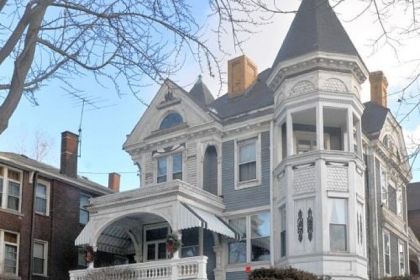 Photo by Larry Roberts/Post-Gazette
Photo by Larry Roberts/Post-Gazette
Exterior of the Wigman house on Brownsville Road, now owned by George and Cathy Lewis.
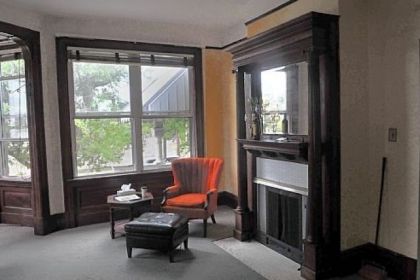 Photo by Larry Roberts/Post-Gazette
Photo by Larry Roberts/Post-Gazette
The front room of the Wigman house in a photograph taken last summer, showing an original fireplace and mantel.
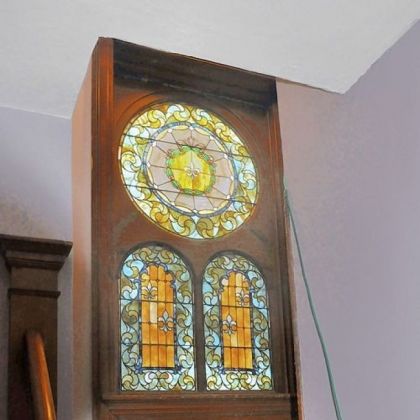 Photo by Larry Roberts/Post-Gazette
Photo by Larry Roberts/Post-Gazette
Stained glass on the landing from the first to second floor in the Wigman house in Carrick.
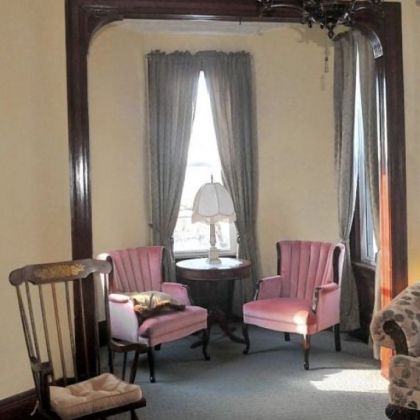 Photo by Larry Roberts/Post-Gazette
Photo by Larry Roberts/Post-Gazette
Sitting area off the living room in the Wigman house.
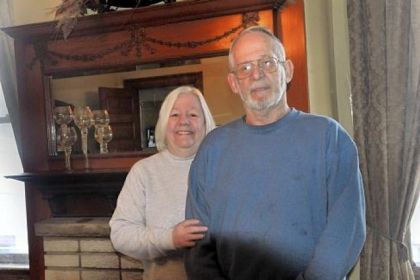 Photo by Larry Roberts/Post-Gazette
Photo by Larry Roberts/Post-Gazette
Cathy and George Lewis, owners of the Wigman house in Carrick, in front of one of the ornamental wooded mantels, this one in the dining room.
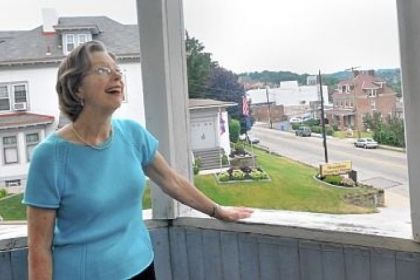 Photo by Larry Roberts/Post-Gazette
Photo by Larry Roberts/Post-Gazette
Kitty Martin, the granddaughter of William Wigman, who built the Queen Anne house at 1425 Brownsville Road in Carrick, examines the workmanship of the second floor balcony off a bedroom.
Kitty Martin beamed as she walked through the Wigman house last summer, delighted by her first chance to tour the Carrick home where her father was born and grew up.
"My grandfather built this house," the Minneapolis woman said as she admired the Victorian woodwork and enjoyed an expansive view of the neighborhood from a second-floor balcony. "My father was born in this house in July 1901."
Her paternal grandfather, William Henry Wigman, ran a South Side lumber company founded in 1866 and initially called the Union Planing Mill Co. When he and his family moved in in 1896, the home's hand-carved oak staircase, pocket doors and moldings were new. So were the cherry wood mantels in the dining room and living room and the three colorful stained-glass windows on the staircase landing. They're still there.
"The most amazing thing to me is that the house was never divided up, and the woodwork was never painted over," Mrs. Martin said.
Another reason to celebrate is that the house still stands. Set on a corner lot, this Queen Anne-style house is the first in an impressive row of houses on a brick-paved street called The Boulevard. This architectural jewel could have become a parking lot for a nearby funeral home. Now, it has historic status and new owners who appreciate its architectural details.
Three white arches frame the front porch. Exterior decoration includes dentil molding and fish scale shingle siding. There's a front-facing gable, a polygonal tower and a second-story balcony that's accessible through an especially tall window in a second-floor bedroom.
Cathy and George Lewis, formerly of Mount Washington, bought the Wigman house last spring for $70,000 and are gradually restoring it. They moved in last September and have rebuilt the front and back porches.
"I always wanted to live in a great big house like that," said Mrs. Lewis, who grew up in Peters, Washington County, and works in the information technology department at the law firm of Houston Harbaugh.
Mr. Lewis is a retired auto mechanic.
"He's becoming very handy. Fortunately, the bones of this house were very, very good. The outside needs a good paint job. We're not going to tackle that on our own," Mrs. Lewis said.
The Lewises saw the spacious home because their daughter, Shannon, considered buying it before purchasing a Brentwood property instead.
"We went and took a second look at it and decided to buy it. We want to ... turn it into a tea room," Mrs. Lewis said, adding that visitors to the Harry Readshaw funeral home, just across the street, would be likely customers. A china cupboard in the foyer already holds an array of 35 colorful tea cups, a gift from one of her cousins.
The Lewises had lots of support from three committed volunteers who founded the Carrick-Overbrook Historical Society -- Julia Tomasic, John Rudiak and Carol Anthony. Another advocate was Bonnie Kramer, who grew up in the Wigman house during the 1950s and lives in a log home in McClellandtown, Fayette County. She persuaded the house's former owner, her stepmother Grace McClory, to let her take the lead on finding a sympathetic buyer.
"I'm not of that generation where you throw away and buy new. Even as a decorator, I try to find a second life and repurpose things. I really felt it was important to make sure the right person bought it," Mrs. Kramer said.
All those efforts paid off when the city's Historic Review Commission designated the house as historic in April 2011. Since last summer, the Lewises have been busy painting the foyer, living room and dining room, using 20 gallons of Behr paint donated by Home Depot. Four of Mrs. Lewis' office mates showed up at 8 a.m. on four Saturdays to attend "painting parties." The crew included Carol Kushner, Corinne McCartney, Karen Schwartz and Jane Settembre. Now, the living room and dining room are gold, and long sage green damask curtains decorate both rooms.
"Carol was known as 'two-coat Carol.' She wears that tag proudly," Mrs. Lewis said.
The slate roof needed repairs, and old knob-and-tube electrical wiring was replaced. New plumbing was installed, too. The Lewises are buying antiques to decorate their new home, including a game table and a pie-crust table for the dining room. At Christmas, they wrapped garlands around the fireplace mantels and decorated a 7-foot tree that stood in the front turret window. An annual gathering of cousins convened here, too.
Just seeing the house where her family grew up was a gift to Mrs. Martin. In the early 1980s, she took her father, Donald Prosser Wigman, to visit Carrick. "He wanted to see his house again. We stood out there on the corner. We never came up and knocked on the door. We thought it had been divided up into apartments," Mrs. Martin said, adding that her father could not bear to see that.
"I'm so thankful to the Lewises for buying this house and to Bonnie [Kramer] for being strong and saying, 'I want this house to be saved.' It just makes me so grateful that somebody loves that house and that it's still standing."
Marylynne Pitz: mpitz@post-gazette.com or 412-263-1648. First Published January 26, 2013 12:00 am
